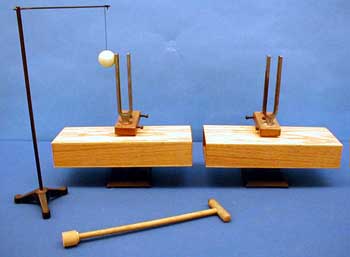Demos: 4B-11 Resonance in Boxes with Tuning Forks

Two identical wooden boxes, open at one end, have identical tuning forks attached at the center of the top of the box. When the tuning fork is struck, the sound is amplified by the resonance occurring in the box. When the one box is placed such that its opening is a few centimeters from the other’s opening, striking one tuning fork sets up a sympathetic vibration in the other, which can be shown by having a ping-pong ball, attached to a thread, lightly touch the second fork. The ping-pong ball will bounce back and forth indicating that the fork is vibrating.
One can also demonstrate beats by attaching a lump of clay to one tine of one of the forks. The mass loading will cause a reduction in frequency of that fork. If both forks are struck simultaneously, beats can clearly be heard.
Directions: Strike each tuning fork to show how the resonance enhances the sound. Then place the boxes so that they face each other, open end to open end. Place the stand holding the ping-pong ball in such a position as to make the ball just lightly touch the tine of the fork. Then strike the other fork. An erratic movement of the ping-pong ball can be seen. (You might want to focus the projection camera on the apparatus for better visibility.)
To show beats, take a lump of clay (about half the amount supplied at first) and stick it to the tine of the fork near the top. Strike each tuning fork and listen for beats. The greater the mass of clay added, the lower the frequency of the fork. Experiment a little to get the beat frequency desired.
Suggestions for Presentation: If available, strike a hand-held tuning fork to show that it is essentially inaudible to all but the nearest listeners. Ask what the purpose of the box might be. Also ask if any size box would do. What does this particular size box have to do with the frequency of forks used?
The ping-pong ball undergoes erratic movement. Why? The resonant swinging frequency of the ball on the string is far lower than the frequency of the fork. However, occasionally the two get “in synch” and a larger amplitude swing occurs.
For the beats, ask what would happen if the fork were mass loaded. Would it “swing back and forth as fast?” What does that have to do with the frequency? If the frequencies are close, what effect will occur? (If you have not yet introduced beats, this might be a good lead in.)
Applications: Resonance boxes such as music boxes, marimbas, etc.
Last Updated: Nov 30, 2023 11:25 AM